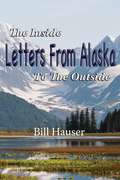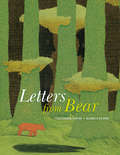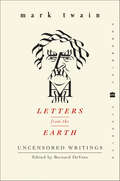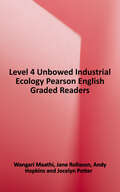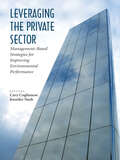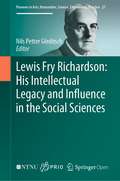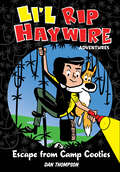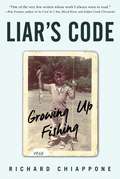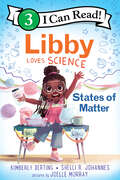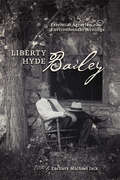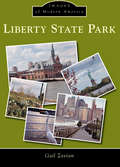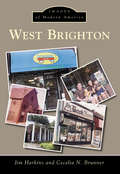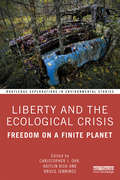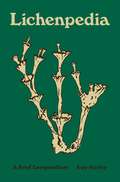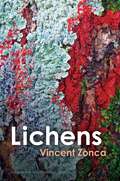- Table View
- List View
Letters From Alaska: The Inside to the Outside
by Bill HauserLetters from Alaska: The Inside to the Outside presents a unique view of the Last Frontier. The reader is treated to a tour of Alaska with the author, Bill Hauser, as he mixes his first-hand, personal experiences with entertaining bits of Alaskana and vivid word pictures. Travel vicariously with him to all parts of the state as he lives, works, and recreates for nearly three decades. Empathize with his tribulations and join in his elations through his on-the-spot observations while you go bear watching, hunting for Dall sheep, moose and caribou, and fishing for king salmon, halibut, and Dolly Varden. Snowmachine on the Iditarod Trail and go on backpack hikes and camping trips with his family. You will learn about the flora and fauna, the landscapes and waterbodies, and the people and places that are Alaska--the Great Land!
Letters Written and Not Sent: Poems
by William Louis-DreyfusThis culmination of a life of poetry, art, and social justice “has the freshness of an opening argument and the majesty of a man’s last words” (Molly Peacock, author of The Analyst).Like paperweights, his lyrics are both small and hefty. His subjects range from race relations to trees, from secrets to parenthood, from ideas of god to kissing, from sons and mothers to fate, and of course, to poetry itself. Never afraid of the big questions of why human beings are alive, and what hope and justice are for, Louis-Dreyfus could take decades to finish a poem. A perfectionist, a thinker, and always inspired by visual art, he fought with himself over how to say what he wanted to say best. Like the French-Uruguayan businessman poet Jules Supervielle, whom Louis-Dreyfus translated, he felt the tug of the financial world against the pull of the lyricism of poetry, and the division marked his life and sparked ideas for his finest poems. As the heart condition that seized him made it absolutely imperative, finishing Letters Written and Not Sent literally became a life-or-death matter. This is the book that he wished to send into the world.“There’s rock-bottom integrity, a dignified modesty, and a quizzical, persistent quest for meaning in this collection. It’s a final bequest to the living from an intensely generous man.” —Rosanna Warren, author of So Forth: Poems“The poems of William Louis-Dreyfus testify to an inner life of great richness, but one that freely slipped across the border of the self into the world beyond . . . a fine collection of his work, and it is good to have it at last.” —Charles Martin, author of Future Perfect
Letters from Bear
by Gauthier DavidBear can&’t imagine a whole winter without her friend, so when Bird migrates south, Bear decides to follow. She&’s never left the forest before, but that won&’t stop her from crossing oceans and mountains—and sending letters along the way. But a surprise is waiting for Bear on the beach… Richly told in amusing letters and lush illustrations, this adventurous story invites readers to consider just how far they&’d go for their friends.
Letters from Camp
by Kate KliseTo the parents of the warring siblings who attend Camp Happy Harmony, the camp seems a godsend. But after they've been there a while, the campers themselves think otherwise. To them, the six middle-aged Harmony siblings who run the camp seem a little "inharmonious." Soon the campers are deep into finding out just what the dastardly Harmonys have in store for them.
Letters from Lighthouse Cottage
by Ali McNamara'An irresistible, feel-good story infused with infectious humour' - Miranda DickinsonThe sun is shining in the quiet little seaside town of SandybridgeSandybridge is the perfect English seaside town: home to gift shops, tea rooms and a fabulous fish and chip shop. And it's home to Grace - although right now, she's not too happy about it. Grace grew up in Sandybridge, helping her parents sort junk from vintage treasures, but she always longed to escape to a bigger world. And she made it, travelling the world for her job, falling in love and starting a family. So why is she back in the tiny seaside town she'd long left behind, hanging out with Charlie, the boy who became her best friend when they were teenagers? It turns out that travelling the world may not have been exactly what Grace needed to do. Perhaps everything she wanted has always been at home - after all, they do say that's where the heart is...
Letters from Lighthouse Cottage
by Ali McNamara'An irresistible, feel-good story infused with infectious humour' - Miranda DickinsonThe sun is shining in the quiet little seaside town of SandybridgeSandybridge is the perfect English seaside town: home to gift shops, tea rooms and a fabulous fish and chip shop. And it's home to Grace - although right now, she's not too happy about it. Grace grew up in Sandybridge, helping her parents sort junk from vintage treasures, but she always longed to escape to a bigger world. And she made it, travelling the world for her job, falling in love and starting a family. So why is she back in the tiny seaside town she'd long left behind, hanging out with Charlie, the boy who became her best friend when they were teenagers? It turns out that travelling the world may not have been exactly what Grace needed to do. Perhaps everything she wanted has always been at home - after all, they do say that's where the heart is...
Letters from the Earth: Uncensored Writings
by Mark Twain“The most impressive contribution to books by Mark Twain since The Mysterious Stranger of 1916...The attitude is that of Swift, the intellectual contempt is that of Voltaire, and the imagination is that of one of the great masters of American writing.”—New York Times Book ReviewVirtually none of the material in Letters from the Earth was published in Twain’s lifetime and the manuscript was only approved by his executors in 1962. This is vintage Twain—sharp, witty, imaginative, wildly funny. His voice is as vigorous and blistering as ever, capable of surprising truth and provoking laughter in the most unlikely places. In this collection, he presents himself as the Father of History, reviewing and interpreting events from the garden of Eden through the Fall and the Flood, translating the papers of Adam and his descendants down through the generations. There are comments on James Fenimore Cooper, English architecture, and the civilization of the French, as well as proposals for a simplified alphabet and a parody of books on etiquette. Letters from the Earth an exuberantly eclectic collection.
Letters to My Grandchildren
by David SuzukiIn this inspiring series of letters to his grandchildren, David Suzuki offers grandfatherly advice mixed with stories from his own remarkable life and explores what makes life meaningful. He challenges his grandchildren - and us - to do everything at full tilt. He explains why sports, fishing, feminism, and failure are important; why it is dangerous to deny our biological nature; and why First Nations must lead a revolution. Drawing on his own experiences and the wisdom he has gained over his long life, he decries the lack of elders and grandparents in the lives of many people, especially immigrants, and champions the importance of heroes. And he even has something to say about fashion. The book also provides an intimate look at Suzuki's life as a father and grandfather with letters that are chock-full of anecdotes about his children and grandchildren when they were small. As he ponders life's deepest questions and offers up a lifetime of wisdom, Suzuki inspires us all to live with courage, conviction, and passion.
Let’s Go For a Walk Outside (Super Simple Storybooks)
by ScholasticGo for a joyful walk with the Rhymington Square monsters in this storybook based on the hit YouTube channel Super Simple’s popular music video “Let’s Go For a Walk Outside.” Includes a scavenger hunt checklist!Let’s go for a walk outside and see what we can see! Let’s go for a walk outside, underneath the trees!Stroll through the neighborhood with the Rhymington Square monsters in this charming storybook based on Super Simple’s catchy music video “Let’s Go For a Walk Outside.” Along the way, see how many things from the list you can spot! Can you find the unicorn? What about the cat-shaped cloud?Includes a scavenger hunt list for you to take along when you go for your own walk around the block!Super Simple has more than 30 million subscribers on YouTube. Now families can enjoy their favorite characters, songs, and stories from the screen with Super Simple board books, storybooks, and activity books!
Level 4: Industrial Ecology (Pearson English Graded Readers Ser.)
by Wangari MaathiPearson English Readers bring language learning to life through the joy of reading. Well-written stories entertain us, make us think, and keep our interest page after page. Pearson English Readers offer teenage and adult learners a huge range of titles, all featuring carefully graded language to make them accessible to learners of all abilities. Through the imagination of some of the world’s greatest authors, the English language comes to life in the pages of our Readers. Students have the pleasure and satisfaction of reading these stories in English, and at the same time develop a broader vocabulary, greater comprehension and reading fluency, improved grammar, and greater confidence and ability to express themselves.
Leveraging the Private Sector: Management-Based Strategies for Improving Environmental Performance
by Cary Coglianese Jennifer NashLeveraging the Private Sector offers the first sustained analysis of public and private sector initiatives designed to encourage firms and industries to use their own management expertise to improve their environmental performance. Cary Coglianese and Jennifer Nash bring together original empirical studies by the nation?s leading experts on recent public and private sector experiments. Do management-based strategies lead to improved environmental outcomes? What kinds of strategies hold the most promise? Leveraging the Private Sector addresses these questions through studies of state pollution prevention planning laws, private sector purchasing requirements, and federal risk management regulations, among others. The contributors show that efforts to leverage private sector experience and knowledge can have a distinctive contribution in the future of environmental protection. Ultimately, a firm's broader management practices shape its environmental performance. Public and private sector strategies that seek to influence these practices directly can help bring about further environmental improvements. This book breaks new ground by investigating a new and promising approach for advancing the economy and the environment.
Lewis Fry Richardson: His Intellectual Legacy And Influence In The Social Sciences (Pioneers in Arts, Humanities, Science, Engineering, Practice #27)
by Nils Petter GleditschThis is an open access book. Lewis F Richardson (1981-1953), a physicist by training, was a pioneer in meteorology and peace research and remains a towering presence in both fields. This edited volume reviews his work and assesses its influence in the social sciences, notably his work on arms races and their consequences, mathematical models, the size distribution of wars, and geographical features of conflict. It contains brief bibliographies of his main publications and of articles and books written about Richardson and his work and discusses his continuing influence in peace research and international relations as well as his attitude to the ethical responsibilities of a scientist. It will be of interest to a wide range of scholars. This book includes 11 chapters written by Nils Petter Gleditsch, Dina A Zinnes, Ron Smith, Paul F Diehl, Kelly Kadera, Mark Crescenzi, Michael D Ward, Kristian Skrede Gleditsch, Nils B Weidmann, Jürgen Scheffran, Niall MacKay, Aaron Clauset, Michael Spagat and Stijn van Weezel.Lewis F Richardson occupied an important position in two academic fields as different as meteorology and peace research, with academic prizes awarded in both disciplines.In peace research, he pioneered the use of mathematical models and the meticulous compilation of databases for empirical research.As a quaker and pacifist, he refused to work in preparations for war, paid a heavy prize in terms of his career, and (at least in the social sciences) was fully recognized as a pioneering scholar only posthumously with the publication of two major books.Lewis Fry Richardson is one of the 20th century’s greatest but least appreciated thinkers—a creative physicist, psychologist, meteorologist, applied mathematician, historian, pacifist, statistician, and witty stylist. If you’ve heard of weather prediction, chaos, fractals, cliometrics, peace science, big data, thick tails, or black swans, then you have benefited from Richardson’s prescience in bringing unruly phenomena into the ambit of scientific understanding. Richardson’s ideas continue to be relevant today, and this collection is a superb retrospective on this brilliant and lovable man.Steven Pinker, Johnstone Professor, Harvard University, and the author of The Better Angels of Our Nature and Enlightenment Now
Li'l Rip Haywire Adventures: Escape from Camp Cooties
by Dan ThompsonRip Haywire thinks he's got it made. Instead of going to bed early, doing fractions and eating Brussels sprouts, he gets to accompany his soldier-of fortune dad on laughably dangerous international missions. He's the only 12-year-old in the world with a working knowledge of the Seven Most Common Booby Traps Used by Ancient Civilizations to Protect Their Precious Treasures. It sure beats school, right? But Rip's life is about to change when his dad, in a sudden fit of responsibility, assigns Rip his toughest mission yet: a historically all-girls summer camp. Will Rip learn how to get along with his feminine camp mates, most of whom have never even seen a flame thrower, let alone used one to fend off a pack of rabid hyenas? Can Rip solve the mysteries that surround the camp and one intriguing girl in particular? Readers will follow Rip's misadventures in his whimsically illustrated journal, helping him to solve puzzles and beat the bad guys, as he learns that friendship can be more valuable than ancient treasure, and more powerful than a well-placed land mine.
Liability for Environmental Harm to the Global Commons (Cambridge Studies on Environment, Energy and Natural Resources Governance)
by Ruth Mackenzie Neil Craik Tara DavenportThis book examines liability for environmental harm in Antarctic, deep seabed, and high seas commons areas, highlighting a unique set of legal questions: Who has standing to claim environmental harms in global commons ecosystems? How should questions of causation and liability be addressed where harm arises from a variety of activities by state and non-state actors? What kinds of harm should be compensable in global commons ecosystems, which are remote and characterized by high levels of scientific uncertainty? How can practical concerns such as ensuring adequate funds for compensation be resolved? This book provides the first in-depth examination and evaluation of current rules and possible avenues for future legal developments in this area of increasing importance for states, international organizations, commercial actors, and legal and governance scholars. This title is part of the Flip it Open Programme and may also be available Open Access. Check our website Cambridge Core for details.
Liar's Code: Growing Up Fishing
by Richard ChiapponeWarm, funny, and memorable musings on a life spent fishing.With this eclectic collection of personal essays taking him from his childhood haunts along the industrial Niagara River of the 1960s to Alaska and the saltwater flats of the Caribbean, Richard Chiappone elongates the fishing-writing genre, suggesting that he finds almost anything a fisherman does interesting-anything but the actual fishing.In one piece, he gets no farther than the curb outside his upstate New York childhood home, futilely waiting for his ride to the rivers of his dreams. In another account he describes an afternoon, standing in a midwinter snow bank, casting to house cats. With humor and self-skewering wit, Chiappone admits he can’t cast very well, ties some of the ugliest flies in the world, and spent nineteen years of his life trying to catch a permit.The essays, both funny and touching, reveal him as a writer of stark contradictions: a man who despises winter and loves living in Alaska; who laments having spent half his life just downstream from the infamous Love Canal, and simultaneously remembers those years with elegiac fondness. Lifting his gaze past the tip of his fly rod, and beyond the river and the fish all the way into his own heart, he portrays everything from a sentimental memory of his mother to his doubts about the adequacy of his grief over a dead daughter, making this compilation a kind of memoir in linked essays-a fisherman’s life examined.Skyhorse Publishing is proud to publish a broad range of books for fishermen. Our books for anglers include titles that focus on fly fishing, bait fishing, fly-casting, spin casting, deep sea fishing, and surf fishing. Our books offer both practical advice on tackle, techniques, knots, and more, as well as lyrical prose on fishing for bass, trout, salmon, crappie, baitfish, catfish, and more. While not every title we publish becomes a New York Times bestseller or a national bestseller, we are committed to publishing books on subjects that are sometimes overlooked by other publishers and to authors whose work might not otherwise find a home.
Libby Loves Science: States of Matter (I Can Read Level 3)
by Kimberly Derting Shelli R. JohannesLibby loves science! In this STEM-themed Level 3 I Can Read! title, Libby and her friends learn about solids, liquids, and gases. A great choice for aspiring scientists, new readers, and fans of Andrea Beaty’s Ada Twist, Scientist. Includes activities, a glossary, and a fun science experiment to do at home.Libby loves science—and experimenting! In this Level 3 I Can Read! title, Libby and her classmates are excited to welcome a new student into their classroom. When the ice cream for the welcome party melts, Libby is curious to see how the three states of matter can save the celebration. Experiment with Libby and find out!The Loves Science books introduce readers to girls who love science, as well as basic concepts of science, technology, engineering, and math. This Level 3 I Can Read! explores how solids, liquids, and gases are all around us, and includes two experiments to try at home or school, as well as a glossary. A great pick for newly independent readers and an ideal companion to Cece Loves Science: Push and Pull, Libby Loves Science: Mix and Measure, Vivi Loves Science: Sink or Float, and Vivi Loves Science: Wind and Water.
Liberalism and the Challenge of Climate Change
by Christopher ShawIn this book Christopher Shaw analyses how liberalism has shaped our understanding of climate change and how liberalism is legitimated in the face of a crisis for which liberalism has no answers. The language and symbolism we use to make sense of climate change arose in the post-World War II liberal institutions of the West. This language and symbolism, in neutralising the philosophical and ideological challenge climate change poses to the legitimacy of free market liberalism, has also closed off the possibility of imagining a different kind of future for humanity. The book is structured around a repurposing of the ‘guardrail’ concept, commonly used in climate science narratives to communicate the boundary between safe and dangerous climate change. Five discursive ‘guardrails’ are identified, which define a boundary between safe and dangerous ideas about how to respond to climate change. The theoretical treatment of these issues is complemented with data from interviews with opinion-formers, decision-makers and campaigners, exploring what models of human nature and political possibilities guide their approach to the politics of climate change governance. This book will be of great interest to students and scholars of climate change, liberal politics, environmental communication and environmental politics and philosophy, in general.
Liberalism and the Challenge of Climate Change
by Christopher ShawIn this book Christopher Shaw analyses how liberalism has shaped our understanding of climate change and how liberalism is legitimated in the face of a crisis for which liberalism has no answers.The language and symbolism we use to make sense of climate change arose in the post-World War II liberal institutions of the West. This language and symbolism, in neutralising the philosophical and ideological challenge climate change poses to the legitimacy of free market liberalism, has also closed off the possibility of imagining a different kind of future for humanity. The book is structured around a repurposing of the ‘guardrail’ concept, commonly used in climate science narratives to communicate the boundary between safe and dangerous climate change. Five discursive ‘guardrails’ are identified, which define a boundary between safe and dangerous ideas about how to respond to climate change. The theoretical treatment of these issues is complemented with data from interviews with opinion-formers, decision-makers and campaigners, exploring what models of human nature and political possibilities guide their approach to the politics of climate change governance.This book will be of great interest to students and scholars of climate change, liberal politics, environmental communication and environmental politics and philosophy, in general.
Libertad (¡Arriba la Lectura!, Level M #23)
by Wendy Macdonald Warren CrossettDiego está seguro de que sus vacaciones de verano serán aburridas. Tiene un brazo fracturado y no puede jugar a la pelota, andar en bicicleta ni hacer muchas cosas en general. Pero esta situación cambia cuando descubre un águila y comienza a llamarla Vuelacielos. NIMAC-sourced textbook
Liberty Hyde Bailey: Essential Agrarian and Environmental Writings
by Liberty Hyde Bailey"Nature-study not only educates, but it educates nature-ward; and nature is ever our companion, whether we will or no. Even though we are determined to shut ourselves in an office, nature sends her messengers. The light, the dark, the moon, the cloud, the rain, the wind, the falling leaf, the fly, the bouquet, the bird, the cockroach-they are all ours. If one is to be happy, he must be in sympathy with common things. He must live in harmony with his environment. One cannot be happy yonder nor tomorrow: he is happy here and now, or never. Our stock of knowledge of common things should be great. Few of us can travel. We must know the things at home."—from "The Meaning of the Nature-study Movement""To feel that one is a useful and cooperating part in nature is to give one kinship, and to open the mind to the great resources and the high enthusiasms. Here arise the fundamental common relations. Here arise also the great emotions and conceptions of sublimity and grandeur, of majesty and awe, the uplift of vast desires—when one contemplates the earth and the universe and desires to take them into the soul and to express oneself in their terms; and here also the responsible practices of life take root."—from The Holy EarthBefore Wendell Berry and Aldo Leopold, there was the horticulturalist and botanist Liberty Hyde Bailey (1858–1954). For Wendell Berry, Bailey was a revelation, a symbol of the nature-minded agrarianism Berry himself popularized. For Aldo Leopold, Bailey offered a model of the scholar-essayist-naturalist. In his revolutionary work of eco-theology, The Holy Earth, Bailey challenged the anthropomorphism—the people-centeredness—of a vulnerable world. A trained scientist writing in the lyrical tradition of Emerson, Burroughs, and Muir, Bailey offered the twentieth century its first exquisitely interdisciplinary biocentric worldview; this Michigan farmer's son defined the intellectual and spiritual foundations of what would become the environmental movement.For nearly a half century, Bailey dominated matters agricultural, environmental, and scientific in the United States. He worked both to improve the lives of rural folk and to preserve the land from which they earned their livelihood. Along the way, he popularized nature study in U.S. classrooms, lobbied successfully for women's rights on and off the farm, and bulwarked Teddy Roosevelt's pioneering conservationism.Here for the first time is an anthology of Bailey's most important writings suitable for the general and scholarly reader alike. Carefully selected and annotated by Zachary Michael Jack, this book offers a comprehensive introduction to Bailey's celebrated and revolutionary thinking on the urgent environmental, agrarian, educational, and ecospiritual dilemmas of his day and our own. Culled from ten of Bailey's most influential works, these lyrical selections highlight Bailey's contributions to the nature-study and the Country Life movements. Published on the one-hundredth anniversary of Bailey's groundbreaking report on behalf of the Country Life Commission, Liberty Hyde Bailey: Essential Agrarian and Environmental Writings will inspire a new generation of nature writers, environmentalists, and those who share with Bailey a profound understanding of the elegance and power of the natural world and humanity's place within it.
Liberty State Park (Images of Modern America)
by Gail ZavianSituated on the Hudson River, the Central Railroad of New Jersey terminal operated its railroad/maritime complex for over 100 years in this area. After its shutdown in 1967, community advocates, already lobbying for nine years, continued their successful campaign for the site to become a public park. With over 1,000 acres, Liberty State Park opened on Flag Day--June 14, 1976. Today, this recreational landscape features the Nature Interpretive Center, Liberty Science Center, and a section of the Hudson River Waterfront Walkway. Liberty State Park, in Jersey City, is the only place in New Jersey where one can board a ferry to visit Ellis Island and the Statue of Liberty. Liberty State Park showcases the rich cultural and environmental history of this landscape's transformation from an abandoned waterfront transportation hub into one of America's most exceptional state parks.
Liberty State Park (Images of Modern America)
by Gail ZavianSituated on the Hudson River, the Central Railroad of New Jersey terminal operated its railroad/maritime complex for over 100 years in this area. After its shutdown in 1967, community advocates, already lobbying for nine years, continued their successful campaign for the site to become a public park. With over 1,000 acres, Liberty State Park opened on Flag Day--June 14, 1976. Today, this recreational landscape features the Nature Interpretive Center, Liberty Science Center, and a section of the Hudson River Waterfront Walkway. Liberty State Park, in Jersey City, is the only place in New Jersey where one can board a ferry to visit Ellis Island and the Statue of Liberty. Liberty State Park showcases the rich cultural and environmental history of this landscape's transformation from an abandoned waterfront transportation hub into one of America's most exceptional state parks.
Liberty and the Ecological Crisis: Freedom on a Finite Planet (Routledge Explorations in Environmental Studies #1)
by Bruce Jennings Christopher J. Orr Kaitlin KishThis book examines the concept of liberty in relation to civilization’s ability to live within ecological limits. Freedom, in all its renditions – choice, thought, action – has become inextricably linked to our understanding of what it means to be modern citizens. And yet, it is our relatively unbounded freedom that has resulted in so much ecological devastation. Liberty has piggy-backed on transformations in human–nature relationships that characterize the Anthropocene: increasing extraction of resources, industrialization, technological development, ecological destruction, and mass production linked to global consumerism. This volume provides a deeply critical examination of the concept of liberty as it relates to environmental politics and ethics in the long view. Contributions explore this entanglement of freedom and the ecological crisis, as well as investigate alternative modernities and more ecologically benign ways of living on Earth. The overarching framework for this collection is that liberty and agency need to be rethought before these strongly held ideals of our age are forced out. On a finite planet, our choices will become limited if we hope to survive the climatic transitions set in motion by uncontrolled consumption of resources and energy over the past 150 years. This volume suggests concrete political and philosophical approaches and governance strategies for learning how to flourish in new ways within the ecological constraints of the planet. Mapping out new ways forward for long-term ecological well-being, this book is essential reading for students and scholars of ecology, environmental ethics, politics, and sociology, and for the wider audience interested in the human–Earth relationship and global sustainability.
Lichenpedia: A Brief Compendium (Pedia Books #11)
by Kay HurleyAn illustrated mini-encyclopedia about the weird and wonderful world of lichensLichenpedia is a delightfully entertaining and beautifully illustrated A–Z treasury about the strange, obscure, and remarkable world of lichens, from their unique and essential roles in nature and the ways they are used in dyeing, brewing, and drug-making to how they have inspired writers and artists, from Henry David Thoreau to modern painters.In 100 brief entries written in a vivid, lively style, Kay Hurley introduces key aspects of lichen biology, environmental roles, emerging uses, scientific history, and myth. She describes the variety of forms that lichens take, from leafy to filamentous to things reminiscent of skin diseases, with imaginative names like witch&’s hair. She explains the surprising ways that birds and beasts—from reindeer and moose down to tiny tardigrades—use lichens, and how lichens survive in extreme environments, from deserts to Antarctica to outer space. Hurley also introduces some of the innovators who have advanced the knowledge of lichens, from the ancient Greek philosopher Theophrastus to today&’s professional lichenologists.With charming drawings by Susan Adele Edwards, Lichenpedia promises to put you in touch with the natural world in a new way by opening your eyes to these vital organisms, which are all around us, hidden in plain sight.Features a cloth cover with an elaborate foil-stamped design
Lichens: Toward a Minimal Resistance
by Vincent ZoncaCovering almost 8 percent of the earth's terrain, lichens are living beings which are familiar to everyone, known to no one. They are one of those organisms that seem to offer nothing to hold our gaze. But the more time we spend with lichens, the more they reveal their beauty, their mysteries and their strange power of attraction. Part-algae and part-fungus, lichens call into question our customary ways of classifying forms of life, and allow us to conceive of an ecology that is no longer based on distinctions between nature and culture, urban and rural, competition and cooperation. The result of several years of investigation carried out on several different continents, this remarkable book offers an original, radical, and, like its subject matter, symbiotic reflection on this common but mostly invisible form of life, blending cultures and disciplines, drawing on biology, ecology, philosophy, literature, poetry, even graphic art. What if lichens were at the heart of some of the most pressing and topical questions of our day? Does the fact that they can live everywhere, even in very harsh environments, that they persist when almost all other traces of life have disappeared, mean that, despite their fragility, lichens are a force of resistance? After reading this book you will never see lichens, or the world, in the same way again.
